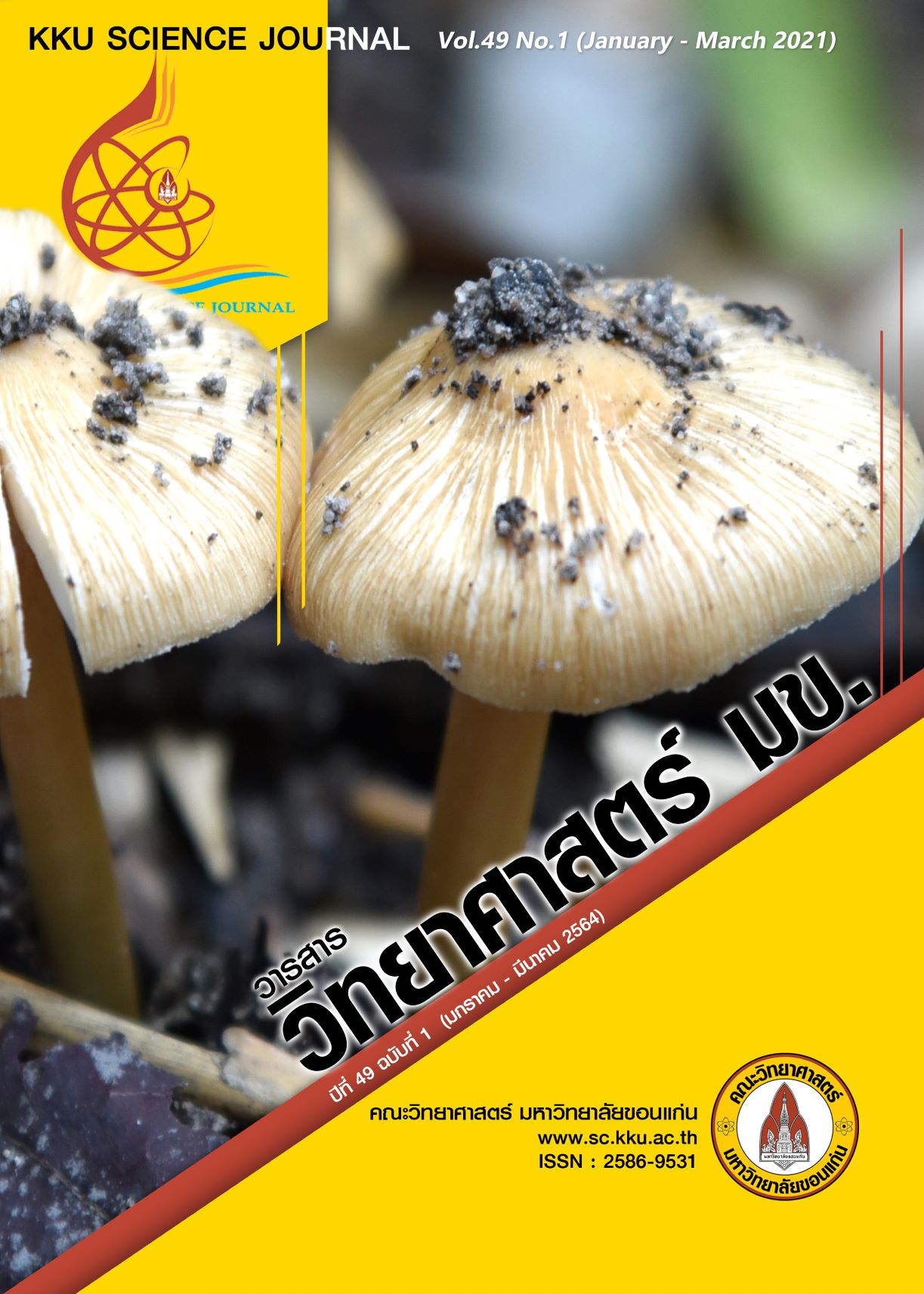การโคลนยีนที่ผลิตเอนไซม์ 1,3-Propanediol dehydrogenase จาก Lactobacillus buchneri
Main Article Content
บทคัดย่อ
ปัจจุบันอุตสาหกรรมด้านเชื้อเพลิงชีวภาพมีการขยายตัวอย่างรวดเร็ว ส่งผลให้กลีเซอรอล ซึ่งเป็นผลผลิตพลอยได้จากการผลิตเชื้อเพลิงชีวภาพมีปริมาณเพิ่มขึ้นอย่างมาก กลีเซอรอลสามารถเปลี่ยนเป็นสาร 1,3-Propanediol (1,3-PD) ซึ่งเป็นสารเคมีพื้นฐานที่ใช้ในกระบวนการอุตสาหกรรมหลายชนิด งานวิจัยนี้ได้ทำการโคลนยีน dhaT ซึ่งถอดรหัสเป็นเอนไซม์ 1,3-Propanediol dehydrogenase (1,3-PDH) ซึ่งเป็นหนึ่งในเอนไซม์ในวิถีการเมแทบอลิซึมกลีเซอรอลไปเป็นสาร 1,3-PD โดยทำการเพิ่มปริมาณยีน dhaT จาก Lactobacillus buchneri ด้วยปฏิกิริยาลูกโซ่พอลิเมอเรส (polymerase chain reaction; PCR) จากนั้นเชื่อมต่อชื้นยีนเข้ากับเวคเตอร์พาหะ pET-28a(+) และนำเข้าสู่ Escherichia coli สายพันธุ์ BL21 ทำการตรวจสอบโคลนด้วยเทคนิค colony PCR และสกัดพลาสมิดลูกผสมเพื่อส่งวิเคราะห์ลำดับเบส ผลการทดลองพบว่า สามารถโคลนยีน dhaT ซึ่งมีขนาด 1,200 คู่เบส จาก L. buchneri ได้สำเร็จ จากการวัดกิจกรรมเอนไซม์ 1,3-PDH ของ E. coli ลูกผสมพบว่ามีค่ากิจกรรมของเอนไซม์เท่ากับ 154.228 mU/ml ในขณะที่ค่ากิจกรรมของเอนไซม์ดังกล่าวใน L. buchneri มีค่าเท่ากับ 208.793 mU/ml จากผลการทดลองเหล่านี้แสดงให้เห็นว่างานวิจัยนี้สามารถแสดงออกโปรตีนจากยีน dhaT ที่โคลนเข้าไปได้สำเร็จ ซึ่งจะได้นำความรู้จากงานวิจัยนี้ไปศึกษาต่อยอดเพื่อพัฒนาการผลิตสาร 1,3-PD จากกลีเซอรอลต่อไป
Article Details

This work is licensed under a Creative Commons Attribution-NonCommercial-NoDerivatives 4.0 International License.
References
Ahrens, K., Menzel, K., Zeng, A. and Deckwer, W. (1998). Kinetic, dynamic, and pathway studies of glycerol metabolism by Klebsiella pneumoniae in anaerobic continuous culture: III. Enzymes and fluxes of glycerol dissimilation and 1 , 3 -propanediol formation. Biotechnology and Bioengineering 59(5): 544-552.
Biebl, H., Menzel, K., Zeng, A. and Deckwer, W. (1999). Microbial production of 1,3-propanediol. Applied Microbiology and Biotechnology 52(3): 289-297.
Fenghuan, W., Huijin, Q., He, H. and Tan, T. (2005). High-Level Expression of the 1,3-Propanediol Oxidoreductase from Klebsiella pneumoniae in Escherichia coli. Molecular Biotechnology 31(3): 211-220.
Froger, A. and Hall, J. E. (2007). Transformation of plasmid DNA into E. coli using the heat shock method. Journal of visualized experiments (6): 253.
Liu, H., Ou, X., Zhou, S., and Liu, D. (2009). Microbial 1,3-Propanediol, Its Copolymerization with Terephthalate, and Applications. Microbiology Monographs Plastics from Bacteria 405-425.
de Man, J. C., Rogosa, M. and Sharpe, M. E. (1960). A Medium for the Cultivation of Lactobacilli. Journal of Applied Bacteriology (23): 130–135.
Maervoet, V. E., Mey, M. D., Beauprez, J., Maeseneire, S. D. and Soetaert, W. K. (2011). Enhancing the Microbial Conversion of Glycerol to 1,3-Propanediol Using Metabolic Engineering. Organic Process Research & Development 15(1): 189-202.
Przystałowska, H., Zeyland, J., Szymanowska-Powałowska, D., Szalata, M., Słomski, R., Lipiński, D. (2015). 1 , 3 -Propanediol production by new recombinant Escherichia coli containing genes from pathogenic bacteria. Microbiological Research 171: 1-7.
Rodríguez, I., Fraga, J., Noda, A. A., Mayet, M., Duarte, Y., Echevarria, E. and Fernández, C. (2014). An Alternative and Rapid Method for the Extraction of Nucleic Acids from Ixodid Ticks by Potassium Acetate Procedure. Brazilian Archives of Biology and Technology 57(4): 542-547.
Skraly, F. A., Lytle, B. L., Cameron, D. C. (1998). Construction and characterization of a 1,3-propanediol operon. Applied and Environmental Microbiology 64: 98-105. Studier, F. W. (2014). Stable expression clones and auto-induction for protein production in E. coli. Methods in Molecular Biology 1091: 17-32.
Veiga-da-Cunha, M. and Foster, M. A. (1992). 1,3-Propanediol: NAD+oxidoreductases of Lactobacillus brevis and Lactobacillus buchneri. Applied and Environmental Microbiology 58(6): 2005-2010.

